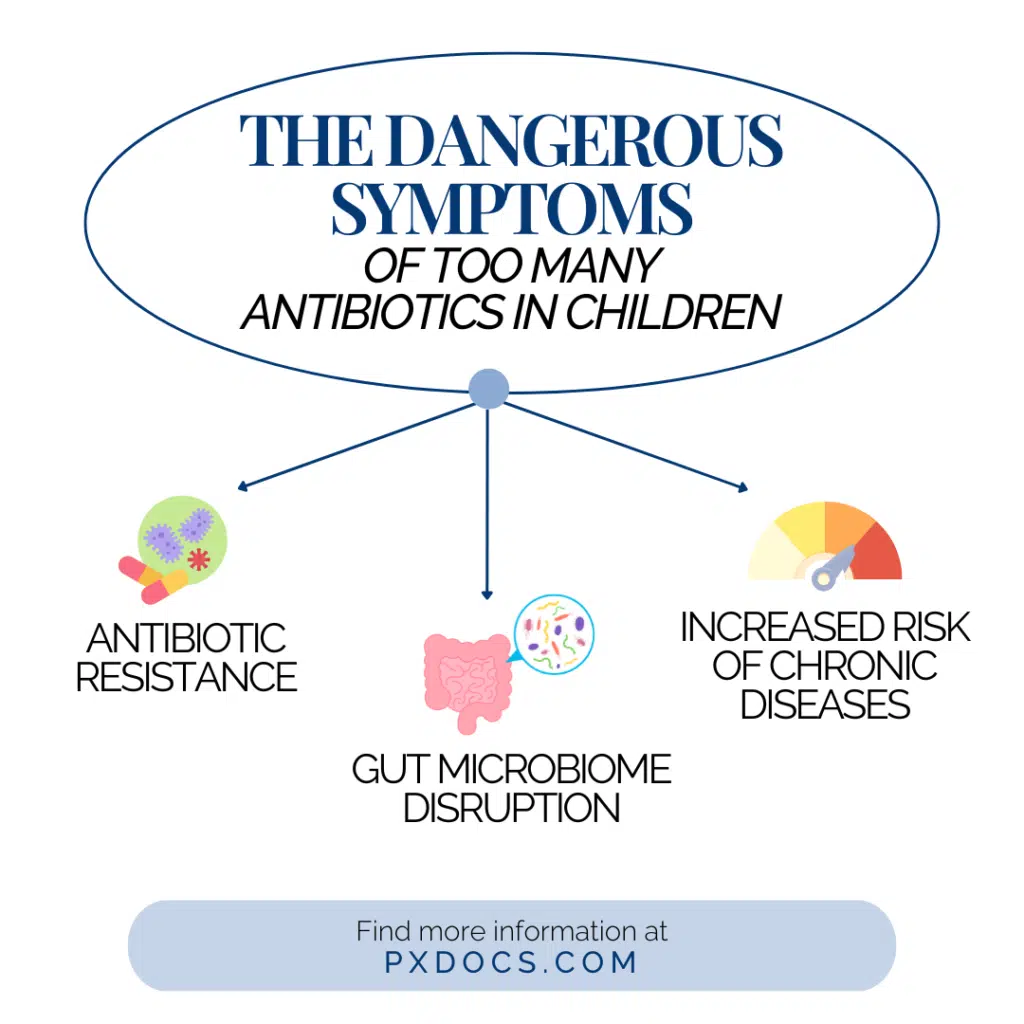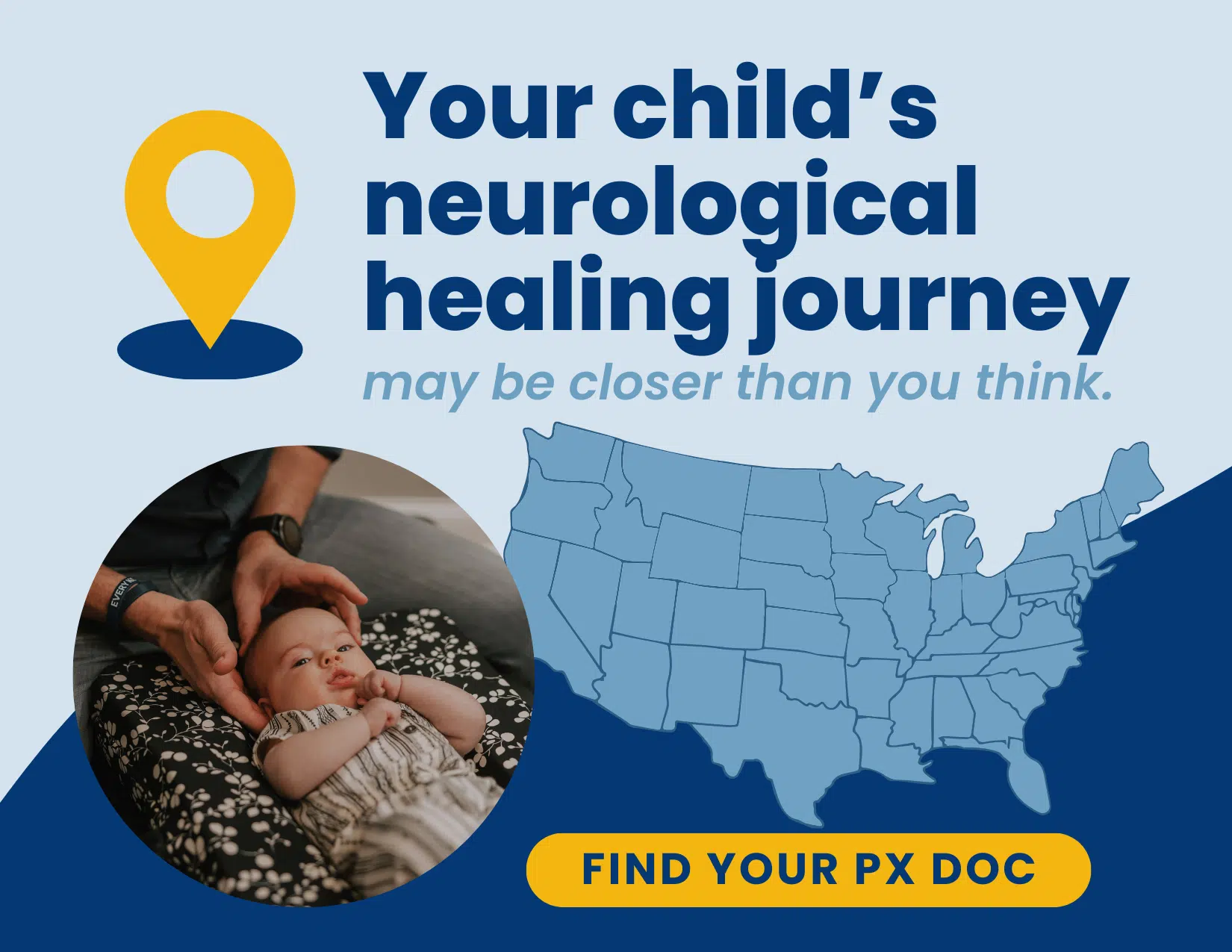As a parent, you’ve likely experienced the helplessness and frustration of watching your child suffer through a painful ear infection or a persistent cough. In these moments, it’s natural to want a quick solution, and antibiotics often seem like the answer. This is especially true when conventional pediatricians and urgent care centers continue to dole them out quite easily, despite updated guidelines that came out years ago cautioning against doing so.
However, the alarming truth is that nearly 30% of antibiotics prescribed are unnecessary, according to the Centers for Disease Control and Prevention (CDC). This rampant overuse of antibiotics not only contributes to the growing threat of antibiotic resistance but also disrupts the delicate balance of your child’s developing nervous system, setting the stage for long-term health consequences.
In this article, we’ll dive deep into the dangers of antibiotic overuse, exploring how it fits into “The Perfect Storm” of factors that can derail your child’s neurological development. We’ll also shed light on the vital role of the nervous system, particularly the vagus nerve, in regulating immune health, inflammation, and overall health, and how chiropractic care can help address the root causes of many childhood illnesses.
What Does Overuse of Antibiotics Look Like?
Antibiotic overuse occurs when these powerful medications are used unnecessarily or incorrectly. While antibiotics can be life-saving when prescribed and used appropriately, they are not without risks. Understanding what constitutes antibiotic overuse is the first step in preventing it and protecting your child’s health.
One of the most common examples of antibiotic overuse in children is prescribing them for viral infections, such as colds, flu, or strep throat. Antibiotics are designed to target bacterial infections and are ineffective against viruses. In fact, taking antibiotics when they are not needed can do more harm than good by wiping out beneficial bacteria in the gut and contributing to antibiotic resistance.
Where so much of this trouble begins is in the case of ear infections, which is one of the most common reasons for pediatric medical visits in the United States, especially for children under the age of 5. Most ear infections are caused by poor drainage of the eustachian tube and lymphatics, as well as a combination of subluxation and inflammation, and they are mostly viral in nature.
Another instance of overuse is giving antibiotics “just in case,” even when there is no clear evidence of a bacterial infection. This precautionary approach may seem prudent, but it can backfire by exposing your child to unnecessary antibiotic side effects.
It’s crucial for parents to understand that not every illness requires antibiotics and that, in many cases, the best course of action is to provide comfort and support while the body works to heal itself. By working closely with a trusted healthcare provider and using antibiotics only when necessary and as prescribed, you can help protect your child’s health and prevent the dangerous consequences of antibiotic overuse.
The Risks and Side Effects of Too Much Antibiotics
While antibiotics work for treating bacterial infections, overusing them comes with a host of risks and consequences that can have lasting effects on your child’s health. From contributing to the rise of antibiotic-resistant superbugs to disrupting the delicate balance of the gut microbiome, the ramifications of antibiotic overuse are far-reaching and can impact your child’s well-being well into adulthood.
One of the most dangerous symptoms of too many antibiotics is the development of antibiotic resistance. When antibiotics are used too frequently or inappropriately, bacteria can evolve to withstand these drugs, leading to the emergence of antibiotic-resistant strains.
These “superbugs” can cause infections that are much harder to treat, often requiring stronger, more expensive antibiotics or even hospitalization. The CDC estimates that antibiotic resistance contributes to nearly 3 million infections and 5 million deaths in 2019 alone.
Another symptom of too many antibiotics is the disruption of the gut microbiome. The human gut is home to trillions of beneficial bacteria that play crucial roles in digestion, immune function, and overall health. Antibiotics, while targeting harmful bacteria, can also wipe out these helpful microbes, throwing the gut ecosystem out of balance. This imbalance, known as dysbiosis, has been linked to a range of health issues, including:
- Inflammatory bowel disease
- Allergies and asthma
- Obesity and metabolic disorders
- Autoimmune conditions
- Neurodevelopmental disorders
In addition to these long-term health risks, antibiotic overuse can also increase the likelihood of immediate side effects. Common adverse reactions to antibiotics include diarrhea, nausea, vomiting, and skin rashes. In more severe cases, antibiotics can cause kidney damage, liver toxicity, or even life-threatening allergic reactions. The more frequently antibiotics are used, the greater the risk of experiencing these side effects.
Finally, the side effects of too many antibiotics burdens the healthcare system, raising costs for families and society. Treating antibiotic-resistant infections requires longer hospital stays, more expensive medications, and increased medical interventions, adding financial strain on families and taxing the healthcare system.

The Overuse of Antibiotics and Chronic Diseases in Kids
Yes, there is evidence suggesting that early exposure to antibiotics, especially in children under the age of 3, may be associated with an increased risk of developing certain conditions later in life, including autoimmune disorders and obesity. The use of antibiotics during this critical period of immune system development can alter the gut microbiota, which plays a significant role in immune system function and metabolism.
- Autoimmune Disorders: Studies have indicated that disruptions in the gut microbiome caused by early antibiotic use might contribute to the development of autoimmune conditions like allergies, asthma, food intolerance, and so forth. This occurs potentially through mechanisms like impaired immune regulation and increased gut permeability.
- Obesity: Research has also shown a link between early antibiotic exposure and an increased risk of obesity. Antibiotics can change the balance of the gut microbiome, leading to changes in how food is digested and how fat is stored in the body, which may increase the risk of obesity.
- Autism Spectrum Disorders (ASD): Some research has suggested a potential link between early antibiotic use and increased risk of ASD. The hypothesis is that antibiotics may disrupt gut microbiota and neurotransmitter production as well, which is thought to influence brain development and function through the gut-brain axis.
- Attention-Deficit/Hyperactivity Disorder (ADHD): There are studies that explore the relationship between early antibiotic exposure and later development of ADHD. The disruption of the gut microbiome early in life might disrupt the gut-brain connection, neurotransmitter imbalance, and contribute to sympathetic dominance.
The Symptoms of Too Many Antibiotics and “The Perfect Storm”
At PX Docs, we often refer to “The Perfect Storm” when discussing the various factors that can contribute to a child’s health challenges. This concept describes how a combination of early life stressors, including antibiotic overuse, can accumulate over time, leading to nervous system dysfunction and setting the stage for chronic health issues.
“The Perfect Storm” often begins before a child is even born, with maternal stress during pregnancy. When a mother experiences high levels of emotional or physical stress, her body releases cortisol and other stress hormones that can cross the placenta and impact the developing fetus.
Birth interventions and trauma, such as c-sections and vacuum extractions, can also play a role. These interventions can cause physical stress and injury, leading to tension that interferes with proper nervous system function. This interference, known as subluxation, can disrupt communication between the brain and body, setting the stage for various health issues.
Early exposure to antibiotics and other medications is another key component of “The Perfect Storm.” When antibiotics are overused in the first years of life, they can wipe out beneficial bacteria and allow harmful microbes to flourish. This can have far-reaching effects on a child’s health, impacting everything from digestion and immune function to brain development and emotional regulation.
As these various stressors accumulate, they can contribute to a state of dysautonomia, or imbalance in the autonomic nervous system. This imbalance can manifest as an overactive “fight or flight” sympathetic response, leaving a child stuck in a perpetual state of hyperarousal and making it difficult for their body to rest, heal, and develop properly.
Preventing an Overuse of Antibiotics: Strategies for Parents and Healthcare Providers
Preventing an overuse of antibiotics starts with a shift in mindset from one of reflexively treating symptoms to one of supporting the body’s innate healing capabilities. As parents, it’s important to understand that not every illness requires antibiotics and that, in many cases, the best course of action is to provide comfort and support while the body works to heal itself.
This is truly where both the training and “philosophical” differences between modern medicine and chiropractic care really show up. While medical doctors are trained to look at the individual systems and parts of the body and just treat the symptoms with medications, Pediatric Chiropractors understand that the most important component of good health is to have all the systems and cells of the body working together. Since the nervous system is the one system that does exactly that, coordinates and keeps everything working well together, we ensure that system is working well and make adjustments to boost the body’s function instead of suppressing it or doing the job for it.
Open communication between parents and healthcare providers is also essential in preventing antibiotic overuse. Don’t hesitate to ask questions about the necessity of antibiotics and to discuss alternative options for treatment.
One of the many reasons parents today love using their PX Doc as their family’s primary health provider and first line of defense is that not only do they report that their kids get sick far less often, but they can then turn to adjustments and natural remedies first, leaving antibiotics as a last resort instead of a first choice.
In addition to judicious antibiotic use, there are many lifestyle habits that can support your child’s overall health and reduce the need for antibiotics. These include:
- Providing a nutrient-dense, whole foods diet
- Remove all highly processed, high-sugar foods, dyes, preservatives, seed oils, etc.
- Encouraging regular physical activity and outdoor play
- Prioritizing sleep and maintaining a consistent sleep schedule
- Teaching stress management techniques, such as deep breathing and mindfulness
- Supporting healthy immune function through breastfeeding, when possible, and avoiding unnecessary exposure to toxins and environmental pollutants
The Role of Neurologically-Focused Chiropractic Care
While preventing antibiotic overuse is crucial, it’s equally important to address the underlying nervous system dysregulation that can contribute to chronic health issues in children. This is where Neurologically-Focused Chiropractic Care comes in.
At PX Docs, our approach is centered around identifying and addressing subluxations that can disrupt communication between the brain and body. Through precise adjustments, we work to restore proper nervous system function, allowing the body to heal and regulate itself more effectively.
Our care plans are guided by advanced diagnostic tools, such as INSiGHT Scans, which provide a detailed look at a child’s nervous system function. These scans allow us to identify areas of concern and to track progress over time, ensuring that our care is always tailored to each child’s unique needs.
Empowering Families to Make Informed Decisions
At the end of the day, our goal at PX Docs is to empower families with the knowledge and tools they need to make informed decisions about their children’s health. By understanding the dangerous symptoms of too many antibiotics, the importance of nervous system function, and the role of Neurologically-Focused Chiropractic Care, parents can take a proactive approach to their children’s well-being and set them up for a lifetime of optimal health.
If you’re concerned about the impact of antibiotic overuse on your child’s health, or if you’re looking for a drug-free approach to addressing chronic health issues, we encourage you to reach out to a PX Docs provider. Our network of skilled, compassionate chiropractors is dedicated to helping children thrive, and we’re here to support you every step of the way.
Together, we can start to say goodbye to antibiotics when unnecessary and create a brighter, healthier future for the next generation, one free from the burden of chronic illness. By prioritizing nervous system health and supporting the body’s innate wisdom, we can help children unlock their full potential and live their best lives.





